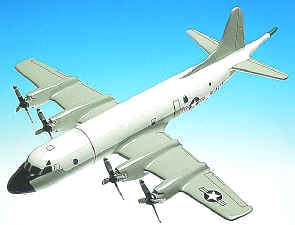|
|
|

|
Lockheed
P-3 Orion |
 |
In 1957, the Navy called for design proposals for a new high-performance anti-submarine
patrol aircraft. It suggested that manufacturers try to adapt an
existing plane to the task. Lockheed won the design contest by adapting its
commercial turboprop, the L-188
Electra. It retained the wings, tail unit,
power plant and much of the fuselage. The latter was
shortened by about seven feet and incorporated a weapons-bay
together with extensive new electronics and other systems. A
prototype of the ASW aircraft (designated YP3V-1 and later
changed to P-3) was first flown in late 1959. The name
"Orion" was adopted in late 1960. Delivery of P-3A
production models to fleet units began in August 1962.
The "Orion" was fully equipped for
its ASW role, with extensive electronics in the fuselage plus
stowage for search stores, and a 13 ft-long unpressurized
bomb-bay equipped to carry torpedoes, depth-bombs, mines or
nuclear weapons. Ten external pylons under the wings could carry
mines or rockets. A searchlight was located under the starboard
wing.
Variants of the P-3 included weather
reconnaissance aircraft and electronic reconnaissance aircraft
that carried special radar, with radomes in long fairings above
and below the fuselage and an additional ventral radome forward
of the wing. P-3A models were followed and replaced in
quick succession by the P-3B and P-3C models each of which
incorporated improved electronics. A limited number of P-3s were
produced for export under the Military Assistance Program. |
|
 |
P-3 Orion
Premier Series. 1/100th scale. 12.5" wingspan x
14" long.
No. AFP2D-PR. Only $174.95 |
 |
P-3
Orion, Grey & White
Standard Series. 1/85th scale.
14" wingspan x 16.25" long.
No. AFP2D-S1. Only $139.95 |
 |
P-3
Orion, All Grey
Standard Series. 1/85th scale.
14" wingspan x 16.25" long.
No. AFP2D-S2. Only $139.95 |
|
|
